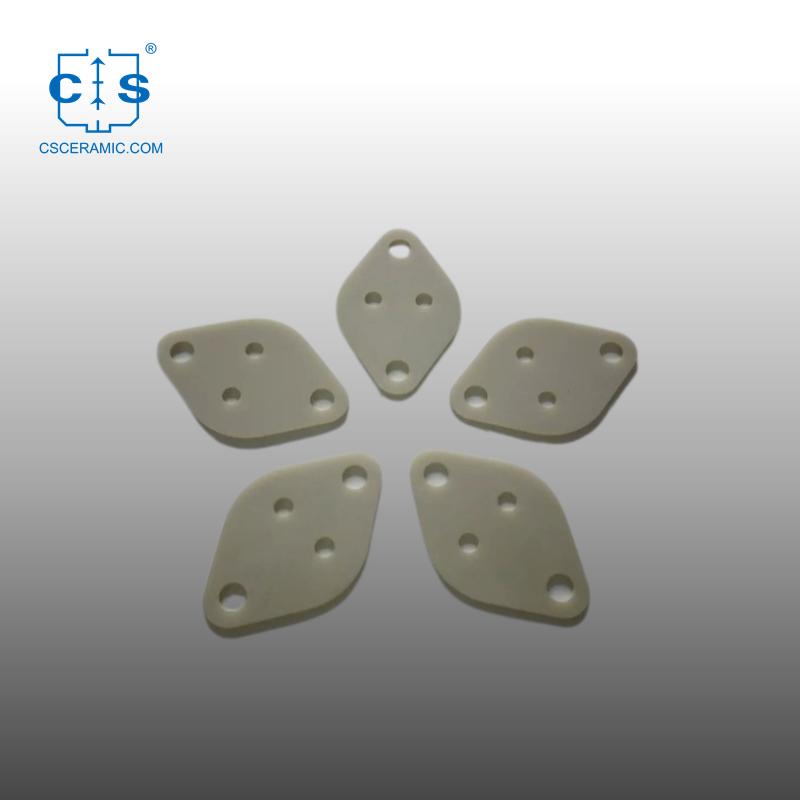–Ъ–µ—А–∞–Љ–Є–Ї–∞ –Є–Ј –љ–Є—В—А–Є–і–∞ –∞–ї—О–Љ–Є–љ–Є—П –њ—А–Њ–Є–Ј–≤–µ–ї–∞ —А–µ–≤–Њ–ї—О—Ж–Є—О –≤ –Љ–Є—А–µ —Б–Њ–≤—А–µ–Љ–µ–љ–љ—Л—Е –Љ–∞—В–µ—А–Є–∞–ї–Њ–≤, –њ—А–µ–і–ї–∞–≥–∞—П —А—П–і –њ—А–µ–Є–Љ—Г—Й–µ—Б—В–≤ –Є —А–∞–Ј–љ–Њ–Њ–±—А–∞–Ј–љ—Л–µ –њ—А–Є–Љ–µ–љ–µ–љ–Є—П. –Я–Њ –Љ–µ—А–µ —А–Њ—Б—В–∞ –µ–≥–Њ –њ–Њ–њ—Г–ї—П—А–љ–Њ—Б—В–Є –Њ—В—А–∞—Б–ї–Є –≤ —А–∞–Ј–ї–Є—З–љ—Л—Е —Б–µ–Ї—В–Њ—А–∞—Е —А–∞—Б–Ї—А—Л–≤–∞—О—В –µ–≥–Њ –љ–µ–≤–µ—А–Њ—П—В–љ—Л–є –њ–Њ—В–µ–љ—Ж–Є–∞–ї.
–С–ї–∞–≥–Њ–і–∞—А—П –Є—Б–Ї–ї—О—З–Є—В–µ–ї—М–љ–Њ–є —В–µ–њ–ї–Њ–њ—А–Њ–≤–Њ–і–љ–Њ—Б—В–Є, –Ї–Њ—В–Њ—А–∞—П –≤ —З–µ—В—Л—А–µ —А–∞–Ј–∞ –њ—А–µ–≤—Л—И–∞–µ—В —В–µ–њ–ї–Њ–њ—А–Њ–≤–Њ–і–љ–Њ—Б—В—М –Њ–Ї—Б–Є–і–∞ –∞–ї—О–Љ–Є–љ–Є—П, –Ї–µ—А–∞–Љ–Є–Ї–∞ –Є–Ј –љ–Є—В—А–Є–і–∞ –∞–ї—О–Љ–Є–љ–Є—П –њ—А–µ–≤–Њ—Б—Е–Њ–і–љ–Њ —А–∞—Б—Б–µ–Є–≤–∞–µ—В —В–µ–њ–ї–Њ, —З—В–Њ –і–µ–ї–∞–µ—В –µ–µ –Є–і–µ–∞–ї—М–љ–Њ–є –і–ї—П –≤—Л—Б–Њ–Ї–Њ—В–µ–Љ–њ–µ—А–∞—В—Г—А–љ—Л—Е –њ—А–Є–Љ–µ–љ–µ–љ–Є–є. –Х–≥–Њ –њ—А–µ–≤–Њ—Б—Е–Њ–і–љ—Л–µ —Н–ї–µ–Ї—В—А–Њ–Є–Ј–Њ–ї—П—Ж–Є–Њ–љ–љ—Л–µ —Б–≤–Њ–є—Б—В–≤–∞ –њ–Њ–Ј–≤–Њ–ї—П—О—В —Н—Д—Д–µ–Ї—В–Є–≤–љ–Њ –њ–µ—А–µ–і–∞–≤–∞—В—М —Н–ї–µ–Ї—В—А–Є—З–µ—Б–Ї—Г—О —Н–љ–µ—А–≥–Є—О –±–µ–Ј —А–Є—Б–Ї–∞ –Ї–Њ—А–Њ—В–Ї–Њ–≥–Њ –Ј–∞–Љ—Л–Ї–∞–љ–Є—П –Є–ї–Є –њ–Њ–ї–Њ–Љ–Ї–Є. –≠—В–Њ –і–µ–ї–∞–µ—В –µ–≥–Њ —Ж–µ–љ–љ—Л–Љ –Ї–Њ–Љ–њ–Њ–љ–µ–љ—В–Њ–Љ –≤ —Б–Є–ї–Њ–≤–Њ–є —Н–ї–µ–Ї—В—А–Њ–љ–Є–Ї–µ, —Б–≤–µ—В–Њ–і–Є–Њ–і–љ–Њ–Љ –Њ—Б–≤–µ—Й–µ–љ–Є–Є –Є –њ–Њ–ї—Г–њ—А–Њ–≤–Њ–і–љ–Є–Ї–Њ–≤—Л—Е —Г—Б—В—А–Њ–є—Б—В–≤–∞—Е.
–£–љ–Є–≤–µ—А—Б–∞–ї—М–љ–Њ—Б—В—М –Ї–µ—А–∞–Љ–Є–Ї–Є –Є–Ј –љ–Є—В—А–Є–і–∞ –∞–ї—О–Љ–Є–љ–Є—П –≤—Л—Е–Њ–і–Є—В –Ј–∞ —А–∞–Љ–Ї–Є —Н–ї–µ–Ї—В—А–Є—З–µ—Б–Ї–Є—Е –Є —В–µ—А–Љ–Є—З–µ—Б–Ї–Є—Е —Б–≤–Њ–є—Б—В–≤. –Х–≥–Њ –≤—Л—Б–Њ–Ї–∞—П —Е–Є–Љ–Є—З–µ—Б–Ї–∞—П —Б—В–∞–±–Є–ї—М–љ–Њ—Б—В—М, –Ї–Њ—А—А–Њ–Ј–Є–Њ–љ–љ–∞—П —Б—В–Њ–є–Ї–Њ—Б—В—М –Є –љ–Є–Ј–Ї–Є–µ –і–Є—Н–ї–µ–Ї—В—А–Є—З–µ—Б–Ї–Є–µ –њ–Њ—В–µ—А–Є –і–µ–ї–∞—О—В –µ–≥–Њ –њ—А–Є–≥–Њ–і–љ—Л–Љ –і–ї—П –њ—А–Є–Љ–µ–љ–µ–љ–Є—П –≤ —Б—Г—А–Њ–≤—Л—Е —Г—Б–ї–Њ–≤–Є—П—Е. –Ю–љ –љ–∞—Е–Њ–і–Є—В –њ—А–Є–Љ–µ–љ–µ–љ–Є–µ –≤ —В–∞–Ї–Є—Е –Њ—В—А–∞—Б–ї—П—Е, –Ї–∞–Ї –∞—Н—А–Њ–Ї–Њ—Б–Љ–Є—З–µ—Б–Ї–∞—П, –∞–≤—В–Њ–Љ–Њ–±–Є–ї—М–љ–∞—П –Є –Љ–µ–і–Є—Ж–Є–љ—Б–Ї–∞—П, —З—В–Њ –њ–Њ–Ј–≤–Њ–ї—П–µ—В —А–∞–Ј—А–∞–±–∞—В—Л–≤–∞—В—М –±–Њ–ї–µ–µ –љ–∞–і–µ–ґ–љ—Л–µ –Є –і–Њ–ї–≥–Њ–≤–µ—З–љ—Л–µ –њ—А–Њ–і—Г–Ї—В—Л.
–Я–Њ—Б–Ї–Њ–ї—М–Ї—Г —Б–њ—А–Њ—Б –љ–∞ —Б–Њ–≤—А–µ–Љ–µ–љ–љ—Л–µ –Љ–∞—В–µ—А–Є–∞–ї—Л —А–∞—Б—В–µ—В, –Ї–µ—А–∞–Љ–Є–Ї–∞ –Є–Ј –љ–Є—В—А–Є–і–∞ –∞–ї—О–Љ–Є–љ–Є—П —Б—В–∞–љ–Њ–≤–Є—В—Б—П –±–µ—Б—Ж–µ–љ–љ—Л–Љ —А–µ—И–µ–љ–Є–µ–Љ, –Њ–±–µ—Б–њ–µ—З–Є–≤–∞—О—Й–Є–Љ –љ–µ–њ—А–µ–≤–Ј–Њ–є–і–µ–љ–љ—Л–µ —Е–∞—А–∞–Ї—В–µ—А–Є—Б—В–Є–Ї–Є –Є –Њ—В–Ї—А—Л–≤–∞—О—Й–Є–Љ –њ—Г—В—М –Ї —В–µ—Е–љ–Њ–ї–Њ–≥–Є—З–µ—Б–Ї–Њ–Љ—Г –њ—А–Њ–≥—А–µ—Б—Б—Г.
–†–∞—Б–Ї—А–Њ–є—В–µ –њ–Њ—В–µ–љ—Ж–Є–∞–ї —Б–Њ–≤—А–µ–Љ–µ–љ–љ—Л—Е –Љ–∞—В–µ—А–Є–∞–ї–Њ–≤ —Б –њ–Њ–Љ–Њ—Й—М—О –Ї–µ—А–∞–Љ–Є–Ї–Є –Є–Ј –љ–Є—В—А–Є–і–∞ –∞–ї—О–Љ–Є–љ–Є—П. –Ю—Й—Г—В–Є—В–µ –њ—А–µ–Є–Љ—Г—Й–µ—Б—В–≤–∞ –Є –Є–Ј—Г—З–Є—В–µ –≤–Њ–Ј–Љ–Њ–ґ–љ–Њ—Б—В–Є –µ–≥–Њ —И–Є—А–Њ–Ї–Њ–≥–Њ –њ—А–Є–Љ–µ–љ–µ–љ–Є—П –≤ —А–∞–Ј–ї–Є—З–љ—Л—Е –Њ—В—А–∞—Б–ї—П—Е.
–Я—А–Є–Љ–µ–љ–µ–љ–Є–µ –Ї–µ—А–∞–Љ–Є–Ї–Є –Є–Ј –љ–Є—В—А–Є–і–∞ –∞–ї—О–Љ–Є–љ–Є—П –≤ —Н–ї–µ–Ї—В—А–Њ–љ–Є–Ї–µ
–Ш—Б–Ї–ї—О—З–Є—В–µ–ї—М–љ—Л–µ —Б–≤–Њ–є—Б—В–≤–∞ –Ї–µ—А–∞–Љ–Є–Ї–Є –Є–Ј –љ–Є—В—А–Є–і–∞ –∞–ї—О–Љ–Є–љ–Є—П –њ—А–Њ–ї–Њ–ґ–Є–ї–Є –њ—Г—В—М –Ї –µ–µ —И–Є—А–Њ–Ї–Њ–Љ—Г –Є—Б–њ–Њ–ї—М–Ј–Њ–≤–∞–љ–Є—О –≤ —Н–ї–µ–Ї—В—А–Њ–љ–љ–Њ–є –њ—А–Њ–Љ—Л—И–ї–µ–љ–љ–Њ—Б—В–Є. –Т –Њ–±–ї–∞—Б—В–Є —Б–Є–ї–Њ–≤–Њ–є —Н–ї–µ–Ї—В—А–Њ–љ–Є–Ї–Є, –≥–і–µ —Н—Д—Д–µ–Ї—В–Є–≤–љ–Њ–µ —А–∞—Б—Б–µ–Є–≤–∞–љ–Є–µ —В–µ–њ–ї–∞ –Є–Љ–µ–µ—В —А–µ—И–∞—О—Й–µ–µ –Ј–љ–∞—З–µ–љ–Є–µ, –Ї–µ—А–∞–Љ–Є–Ї–∞ –Є–Ј –љ–Є—В—А–Є–і–∞ –∞–ї—О–Љ–Є–љ–Є—П —П–≤–ї—П–µ—В—Б—П –њ—А–µ–і–њ–Њ—З—В–Є—В–µ–ї—М–љ—Л–Љ –Љ–∞—В–µ—А–Є–∞–ї–Њ–Љ –і–ї—П –њ–Њ–і–ї–Њ–ґ–µ–Ї –Є —А–∞–і–Є–∞—В–Њ—А–Њ–≤. –Х–≥–Њ –≤—Л—Б–Њ–Ї–∞—П —В–µ–њ–ї–Њ–њ—А–Њ–≤–Њ–і–љ–Њ—Б—В—М –њ–Њ–Ј–≤–Њ–ї—П–µ—В –±—Л—Б—В—А–Њ –Њ—В–≤–Њ–і–Є—В—М —В–µ–њ–ї–Њ –Њ—В —З—Г–≤—Б—В–≤–Є—В–µ–ї—М–љ—Л—Е —Н–ї–µ–Ї—В—А–Њ–љ–љ—Л—Е –Ї–Њ–Љ–њ–Њ–љ–µ–љ—В–Њ–≤, —Б–љ–Є–ґ–∞—П —А–Є—Б–Ї –њ–µ—А–µ–≥—А–µ–≤–∞ –Є –Њ–±–µ—Б–њ–µ—З–Є–≤–∞—П –Њ–њ—В–Є–Љ–∞–ї—М–љ—Г—О –њ—А–Њ–Є–Ј–≤–Њ–і–Є—В–µ–ї—М–љ–Њ—Б—В—М. –≠—В–Њ –і–µ–ї–∞–µ—В –µ–≥–Њ –Є–і–µ–∞–ї—М–љ—Л–Љ –≤—Л–±–Њ—А–Њ–Љ –і–ї—П —В–∞–Ї–Є—Е –њ—А–Є–Љ–µ–љ–µ–љ–Є–є, –Ї–∞–Ї —Б–Є–ї–Њ–≤—Л–µ –Љ–Њ–і—Г–ї–Є –Є –Є–љ–≤–µ—А—В–Њ—А—Л.
–С–Њ–ї–µ–µ —В–Њ–≥–Њ, —Н–ї–µ–Ї—В—А–Њ–Є–Ј–Њ–ї—П—Ж–Є–Њ–љ–љ—Л–µ —Б–≤–Њ–є—Б—В–≤–∞ –Ї–µ—А–∞–Љ–Є–Ї–Є –Є–Ј –љ–Є—В—А–Є–і–∞ –∞–ї—О–Љ–Є–љ–Є—П –і–µ–ї–∞—О—В –µ–µ –љ–µ–Ј–∞–Љ–µ–љ–Є–Љ–Њ–є –≤ —Н–ї–µ–Ї—В—А–Њ–љ–љ—Л—Е —Г—Б—В—А–Њ–є—Б—В–≤–∞—Е, –≥–і–µ –љ–µ–Њ–±—Е–Њ–і–Є–Љ–Њ —В—Й–∞—В–µ–ї—М–љ–Њ –Ї–Њ–љ—В—А–Њ–ї–Є—А–Њ–≤–∞—В—М —Н–ї–µ–Ї—В—А–Њ–њ—А–Њ–≤–Њ–і–љ–Њ—Б—В—М. –Т –њ—А–Њ–Є–Ј–≤–Њ–і—Б—В–≤–µ –њ–Њ–ї—Г–њ—А–Њ–≤–Њ–і–љ–Є–Ї–Њ–≤, –≥–і–µ —В–Њ—З–љ–Њ—Б—В—М –Є –љ–∞–і–µ–ґ–љ–Њ—Б—В—М –Є–Љ–µ—О—В –њ–µ—А–≤–Њ—Б—В–µ–њ–µ–љ–љ–Њ–µ –Ј–љ–∞—З–µ–љ–Є–µ, –Є—Б–њ–Њ–ї—М–Ј–Њ–≤–∞–љ–Є–µ –Ї–µ—А–∞–Љ–Є–Ї–Є –Є–Ј –љ–Є—В—А–Є–і–∞ –∞–ї—О–Љ–Є–љ–Є—П –≤ –Ї–∞—З–µ—Б—В–≤–µ –Љ–∞—В–µ—А–Є–∞–ї–∞ –њ–Њ–і–ї–Њ–ґ–Ї–Є –Њ–±–µ—Б–њ–µ—З–Є–≤–∞–µ—В —Н—Д—Д–µ–Ї—В–Є–≤–љ—Г—О —А–∞–±–Њ—В—Г —З—Г–≤—Б—В–≤–Є—В–µ–ї—М–љ—Л—Е —Н–ї–µ–Ї—В—А–Њ–љ–љ—Л—Е –Ї–Њ–Љ–њ–Њ–љ–µ–љ—В–Њ–≤. –Х–≥–Њ —Б–њ–Њ—Б–Њ–±–љ–Њ—Б—В—М —Б–Њ—Е—А–∞–љ—П—В—М —Н–ї–µ–Ї—В—А–Є—З–µ—Б–Ї—Г—О –Є–Ј–Њ–ї—П—Ж–Є—О –і–∞–ґ–µ –њ—А–Є –≤—Л—Б–Њ–Ї–Є—Е —В–µ–Љ–њ–µ—А–∞—В—Г—А–∞—Е –Є —Б—Г—А–Њ–≤—Л—Е —Г—Б–ї–Њ–≤–Є—П—Е –і–µ–ї–∞–µ—В –µ–≥–Њ –љ–∞–і–µ–ґ–љ—Л–Љ –Љ–∞—В–µ—А–Є–∞–ї–Њ–Љ –і–ї—П —И–Є—А–Њ–Ї–Њ–≥–Њ —Б–њ–µ–Ї—В—А–∞ —Н–ї–µ–Ї—В—А–Њ–љ–љ—Л—Е –њ—А–Є–ї–Њ–ґ–µ–љ–Є–є, –Њ—В —В—А–∞–љ–Ј–Є—Б—В–Њ—А–Њ–≤ –і–Њ –і–∞—В—З–Є–Ї–Њ–≤.
–Ъ—А–Њ–Љ–µ —В–Њ–≥–Њ, —Е–Є–Љ–Є—З–µ—Б–Ї–∞—П —Б—В–∞–±–Є–ї—М–љ–Њ—Б—В—М –Є –Ї–Њ—А—А–Њ–Ј–Є–Њ–љ–љ–∞—П —Б—В–Њ–є–Ї–Њ—Б—В—М –Ї–µ—А–∞–Љ–Є–Ї–Є –Є–Ј –љ–Є—В—А–Є–і–∞ –∞–ї—О–Љ–Є–љ–Є—П –і–µ–ї–∞—О—В –µ–µ –њ–Њ–і—Е–Њ–і—П—Й–µ–є –і–ї—П —Н–ї–µ–Ї—В—А–Њ–љ–љ—Л—Е –Ї–Њ–Љ–њ–Њ–љ–µ–љ—В–Њ–≤, –њ–Њ–і–≤–µ—А–≥–∞—О—Й–Є—Е—Б—П –≤–Њ–Ј–і–µ–є—Б—В–≤–Є—О –∞–≥—А–µ—Б—Б–Є–≤–љ—Л—Е —Б—А–µ–і. –Т —В–µ—Е —Б–ї—Г—З–∞—П—Е, –Ї–Њ–≥–і–∞ –≤–ї–∞–≥–∞, —Е–Є–Љ–Є–Ї–∞—В—Л –Є–ї–Є –і—А—Г–≥–Є–µ –∞–≥—А–µ—Б—Б–Є–≤–љ—Л–µ –≤–µ—Й–µ—Б—В–≤–∞ –Љ–Њ–≥—Г—В –њ—А–µ–і—Б—В–∞–≤–ї—П—В—М –Њ–њ–∞—Б–љ–Њ—Б—В—М, –Ї–µ—А–∞–Љ–Є–Ї–∞ –Є–Ј –љ–Є—В—А–Є–і–∞ –∞–ї—О–Љ–Є–љ–Є—П –Њ–±–µ—Б–њ–µ—З–Є–≤–∞–µ—В –љ–∞–і–µ–ґ–љ—Л–є –±–∞—А—М–µ—А, –Ј–∞—Й–Є—Й–∞—О—Й–Є–є —З—Г–≤—Б—В–≤–Є—В–µ–ї—М–љ—Г—О —Н–ї–µ–Ї—В—А–Њ–љ–Є–Ї—Г –Њ—В –њ–Њ–≤—А–µ–ґ–і–µ–љ–Є–є. –Ґ–∞–Ї–∞—П –і–Њ–ї–≥–Њ–≤–µ—З–љ–Њ—Б—В—М –Є –Њ—В–Ї–∞–Ј–Њ—Г—Б—В–Њ–є—З–Є–≤–Њ—Б—В—М –і–µ–ї–∞—О—В –µ–≥–Њ –Є–і–µ–∞–ї—М–љ—Л–Љ –≤—Л–±–Њ—А–Њ–Љ –і–ї—П –Ї–Њ–Љ–њ–Њ–љ–µ–љ—В–Њ–≤, –Є—Б–њ–Њ–ї—М–Ј—Г–µ–Љ—Л—Е –≤ –њ—А–Њ–Љ—Л—И–ї–µ–љ–љ–Њ–є –∞–≤—В–Њ–Љ–∞—В–Є–Ј–∞—Ж–Є–Є, —В–µ–ї–µ–Ї–Њ–Љ–Љ—Г–љ–Є–Ї–∞—Ж–Є—П—Е –Є –∞–≤—В–Њ–Љ–Њ–±–Є–ї—М–љ–Њ–є —Н–ї–µ–Ї—В—А–Њ–љ–Є–Ї–µ, –≥–і–µ –љ–∞–і–µ–ґ–љ–Њ—Б—В—М –љ–µ –њ–Њ–і–ї–µ–ґ–Є—В –Њ–±—Б—Г–ґ–і–µ–љ–Є—О.
–Я—А–Є–Љ–µ–љ–µ–љ–Є–µ –Ї–µ—А–∞–Љ–Є–Ї–Є –Є–Ј –љ–Є—В—А–Є–і–∞ –∞–ї—О–Љ–Є–љ–Є—П –≤ —В–µ—А–Љ–Њ—А–µ–≥—Г–ї–Є—А–Њ–≤–∞–љ–Є–Є
–Я—А–µ–≤–Њ—Б—Е–Њ–і–љ–∞—П —В–µ–њ–ї–Њ–њ—А–Њ–≤–Њ–і–љ–Њ—Б—В—М –Ї–µ—А–∞–Љ–Є–Ї–Є –Є–Ј –љ–Є—В—А–Є–і–∞ –∞–ї—О–Љ–Є–љ–Є—П –і–µ–ї–∞–µ—В –µ–µ –Њ—В–ї–Є—З–љ—Л–Љ –Љ–∞—В–µ—А–Є–∞–ї–Њ–Љ –і–ї—П —В–µ—А–Љ–Њ—А–µ–≥—Г–ї–Є—А–Њ–≤–∞–љ–Є—П –≤ —А–∞–Ј–ї–Є—З–љ—Л—Е –Њ—В—А–∞—Б–ї—П—Е –њ—А–Њ–Љ—Л—И–ї–µ–љ–љ–Њ—Б—В–Є. –Т —Б—Д–µ—А–µ —Б–≤–µ—В–Њ–і–Є–Њ–і–љ–Њ–≥–Њ –Њ—Б–≤–µ—Й–µ–љ–Є—П, –≥–і–µ —А–∞—Б—Б–µ–Є–≤–∞–љ–Є–µ —В–µ–њ–ї–∞ –Є–Љ–µ–µ—В —А–µ—И–∞—О—Й–µ–µ –Ј–љ–∞—З–µ–љ–Є–µ –і–ї—П –њ–Њ–і–і–µ—А–ґ–∞–љ–Є—П –њ—А–Њ–Є–Ј–≤–Њ–і–Є—В–µ–ї—М–љ–Њ—Б—В–Є –Є –і–Њ–ї–≥–Њ–≤–µ—З–љ–Њ—Б—В–Є, –≤ –Ї–∞—З–µ—Б—В–≤–µ –Љ–∞—В–µ—А–Є–∞–ї–∞ –њ–Њ–і–ї–Њ–ґ–Ї–Є —И–Є—А–Њ–Ї–Њ –Є—Б–њ–Њ–ї—М–Ј—Г–µ—В—Б—П –Ї–µ—А–∞–Љ–Є–Ї–∞ –Є–Ј –љ–Є—В—А–Є–і–∞ –∞–ї—О–Љ–Є–љ–Є—П. –Х–≥–Њ —Б–њ–Њ—Б–Њ–±–љ–Њ—Б—В—М —Н—Д—Д–µ–Ї—В–Є–≤–љ–Њ –Њ—В–≤–Њ–і–Є—В—М —В–µ–њ–ї–Њ –Њ—В —Б–≤–µ—В–Њ–і–Є–Њ–і–љ—Л—Е —З–Є–њ–Њ–≤ –Њ–±–µ—Б–њ–µ—З–Є–≤–∞–µ—В –Њ–њ—В–Є–Љ–∞–ї—М–љ—Л–µ —А–∞–±–Њ—З–Є–µ —В–µ–Љ–њ–µ—А–∞—В—Г—А—Л, —З—В–Њ –њ—А–Є–≤–Њ–і–Є—В –Ї –њ–Њ–≤—Л—И–µ–љ–Є—О —Б–≤–µ—В–Њ–Њ—В–і–∞—З–Є –Є —Г–≤–µ–ї–Є—З–µ–љ–Є—О —Б—А–Њ–Ї–∞ —Б–ї—Г–ґ–±—Л. –≠—В–Њ –і–µ–ї–∞–µ—В –µ–≥–Њ –љ–µ–Ј–∞–Љ–µ–љ–Є–Љ—Л–Љ –Љ–∞—В–µ—А–Є–∞–ї–Њ–Љ –і–ї—П –≤—Л—Б–Њ–Ї–Њ–њ—А–Њ–Є–Ј–≤–Њ–і–Є—В–µ–ї—М–љ—Л—Е —Б–≤–µ—В–Њ–і–Є–Њ–і–Њ–≤.
–Ъ—А–Њ–Љ–µ —В–Њ–≥–Њ, —В–µ—А–Љ–Є—З–µ—Б–Ї–∞—П —Б—В–∞–±–Є–ї—М–љ–Њ—Б—В—М –Ї–µ—А–∞–Љ–Є–Ї–Є –Є–Ј –љ–Є—В—А–Є–і–∞ –∞–ї—О–Љ–Є–љ–Є—П –і–µ–ї–∞–µ—В –µ–µ –њ—А–µ–і–њ–Њ—З—В–Є—В–µ–ї—М–љ—Л–Љ –≤—Л–±–Њ—А–Њ–Љ –і–ї—П –њ—А–Є–Љ–µ–љ–µ–љ–Є–є, —В—А–µ–±—Г—О—Й–Є—Е —Г—Б—В–Њ–є—З–Є–≤–Њ—Б—В–Є –Ї —В–µ—А–Љ–Њ—Ж–Є–Ї–ї–Є—А–Њ–≤–∞–љ–Є—О. –Т –∞–≤—В–Њ–Љ–Њ–±–Є–ї—М–љ–Њ–є —Н–ї–µ–Ї—В—А–Њ–љ–Є–Ї–µ, –≥–і–µ –Ї–Њ–Љ–њ–Њ–љ–µ–љ—В—Л –≤–Њ –≤—А–µ–Љ—П —А–∞–±–Њ—В—Л –њ–Њ–і–≤–µ—А–≥–∞—О—В—Б—П –Ї–Њ–ї–µ–±–∞–љ–Є—П–Љ —В–µ–Љ–њ–µ—А–∞—В—Г—А—Л, –Є—Б–њ–Њ–ї—М–Ј–Њ–≤–∞–љ–Є–µ –Ї–µ—А–∞–Љ–Є–Ї–Є –Є–Ј –љ–Є—В—А–Є–і–∞ –∞–ї—О–Љ–Є–љ–Є—П –Њ–±–µ—Б–њ–µ—З–Є–≤–∞–µ—В –љ–∞–і–µ–ґ–љ—Г—О —А–∞–±–Њ—В—Г –≤ —Б–ї–Њ–ґ–љ—Л—Е —Г—Б–ї–Њ–≤–Є—П—Е. –Х–≥–Њ —Б–њ–Њ—Б–Њ–±–љ–Њ—Б—В—М –≤—Л–і–µ—А–ґ–Є–≤–∞—В—М —В–µ—А–Љ–Є—З–µ—Б–Ї–Є–µ —Г–і–∞—А—Л –Є —Б–Њ—Е—А–∞–љ—П—В—М —Б—В—А—Г–Ї—В—Г—А–љ—Г—О —Ж–µ–ї–Њ—Б—В–љ–Њ—Б—В—М –≤ —И–Є—А–Њ–Ї–Њ–Љ –і–Є–∞–њ–∞–Ј–Њ–љ–µ —В–µ–Љ–њ–µ—А–∞—В—Г—А –і–µ–ї–∞–µ—В –µ–≥–Њ –љ–∞–і–µ–ґ–љ—Л–Љ –Љ–∞—В–µ—А–Є–∞–ї–Њ–Љ –і–ї—П –∞–≤—В–Њ–Љ–Њ–±–Є–ї—М–љ—Л—Е –і–∞—В—З–Є–Ї–Њ–≤, —Б–Є–ї–Њ–≤—Л—Е –Љ–Њ–і—Г–ї–µ–є –Є –і—А—Г–≥–Є—Е –Ї—А–Є—В–Є—З–µ—Б–Ї–Є –≤–∞–ґ–љ—Л—Е –Ї–Њ–Љ–њ–Њ–љ–µ–љ—В–Њ–≤.
–С–Њ–ї–µ–µ —В–Њ–≥–Њ, –ї–µ–≥–Ї–Є–є –≤–µ—Б –Ї–µ—А–∞–Љ–Є–Ї–Є –Є–Ј –љ–Є—В—А–Є–і–∞ –∞–ї—О–Љ–Є–љ–Є—П –µ—Й–µ –±–Њ–ї—М—И–µ –њ–Њ–≤—Л—И–∞–µ—В –µ–µ –њ—А–Є–≤–ї–µ–Ї–∞—В–µ–ї—М–љ–Њ—Б—В—М –і–ї—П –њ—А–Є–Љ–µ–љ–µ–љ–Є–є –≤ –Њ–±–ї–∞—Б—В–Є —В–µ—А–Љ–Њ—А–µ–≥—Г–ї–Є—А–Њ–≤–∞–љ–Є—П, –≥–і–µ —Б–љ–Є–ґ–µ–љ–Є–µ –≤–µ—Б–∞ —П–≤–ї—П–µ—В—Б—П –њ—А–Є–Њ—А–Є—В–µ—В–Њ–Љ. –Т –∞—Н—А–Њ–Ї–Њ—Б–Љ–Є—З–µ—Б–Ї–Њ–є –Є –Њ–±–Њ—А–Њ–љ–љ–Њ–є –њ—А–Њ–Љ—Л—И–ї–µ–љ–љ–Њ—Б—В–Є, –≥–і–µ —Н–Ї–Њ–љ–Њ–Љ–Є—П –≤–µ—Б–∞ –Љ–Њ–ґ–µ—В –њ—А–Є–≤–µ—Б—В–Є –Ї –њ–Њ–≤—Л—И–µ–љ–Є—О —В–Њ–њ–ї–Є–≤–љ–Њ–є —Н—Д—Д–µ–Ї—В–Є–≤–љ–Њ—Б—В–Є –Є –≥—А—Г–Ј–Њ–њ–Њ–і—К–µ–Љ–љ–Њ—Б—В–Є, –Ї–µ—А–∞–Љ–Є–Ї–∞ –Є–Ј –љ–Є—В—А–Є–і–∞ –∞–ї—О–Љ–Є–љ–Є—П –Є—Б–њ–Њ–ї—М–Ј—Г–µ—В—Б—П –≤ —А–∞–і–Є–∞—В–Њ—А–∞—Е, –њ–Њ–і–ї–Њ–ґ–Ї–∞—Е –Є —В–µ–њ–ї–Њ—А–∞—Б–њ—А–µ–і–µ–ї–Є—В–µ–ї—П—Е –і–ї—П –і–Њ—Б—В–Є–ґ–µ–љ–Є—П –Њ–њ—В–Є–Љ–∞–ї—М–љ—Л—Е —В–µ–њ–ї–Њ–≤—Л—Е —Е–∞—А–∞–Ї—В–µ—А–Є—Б—В–Є–Ї –±–µ–Ј —Г–≤–µ–ї–Є—З–µ–љ–Є—П –ї–Є—И–љ–µ–≥–Њ –Њ–±—К–µ–Љ–∞. –Ґ–∞–Ї–Њ–µ —Б–Њ—З–µ—В–∞–љ–Є–µ —В–µ—А–Љ–Є—З–µ—Б–Ї–Њ–є —Н—Д—Д–µ–Ї—В–Є–≤–љ–Њ—Б—В–Є –Є –ї–µ–≥–Ї–Њ–≥–Њ –≤–µ—Б–∞ –і–µ–ї–∞–µ—В –µ–≥–Њ –≤–Њ—Б—В—А–µ–±–Њ–≤–∞–љ–љ—Л–Љ –Љ–∞—В–µ—А–Є–∞–ї–Њ–Љ –і–ї—П –њ–µ—А–µ–і–Њ–≤—Л—Е —А–µ—И–µ–љ–Є–є –њ–Њ —Г–њ—А–∞–≤–ї–µ–љ–Є—О —В–µ–Љ–њ–µ—А–∞—В—Г—А–љ—Л–Љ —А–µ–ґ–Є–Љ–Њ–Љ.

–Я—А–Є–Љ–µ–љ–µ–љ–Є–µ –Ї–µ—А–∞–Љ–Є–Ї–Є –Є–Ј –љ–Є—В—А–Є–і–∞ –∞–ї—О–Љ–Є–љ–Є—П –≤ –Њ–њ—В–Њ—Н–ї–µ–Ї—В—А–Њ–љ–Є–Ї–µ
The unique properties of aluminium nitride ceramic make it well-suited for optoelectronic applications that require precision, reliability, and efficiency. In the field of laser diodes, where thermal management is crucial for maintaining stable output power and wavelength, aluminium nitride ceramic is used as a substrate material to dissipate heat effectively. Its high thermal conductivity ensures rapid heat transfer away from the laser diode, preventing thermal drift and ensuring consistent performance over time. This makes it an ideal choice for high-power laser applications where thermal stability is paramount.
Additionally, the electrical insulation properties of aluminium nitride ceramic are highly beneficial in optoelectronic devices where electrical isolation is essential. In optical communication systems, where signal integrity and transmission efficiency are critical, the use of aluminium nitride ceramic components helps prevent signal degradation and interference. Its ability to provide reliable electrical insulation even in high-frequency applications ensures the integrity of optical signals, making it a preferred material for components such as waveguides, lenses, and optical filters.
Furthermore, the optical transparency of aluminium nitride ceramic in the ultraviolet to infrared spectrum makes it an ideal material for optoelectronic devices that operate across a wide range of wavelengths. In applications such as UV LEDs, photodetectors, and optical sensors, aluminium nitride ceramic's optical clarity allows for efficient transmission and detection of light, enabling the development of high-performance optoelectronic systems. Its versatility in optical applications, combined with its thermal and electrical properties, positions it as a key material for advancing optoelectronic technologies.
Properties of Aluminium Nitride Ceramic
Aluminium nitride ceramic possesses a unique combination of properties that set it apart as a superior material for various applications. One of its key features is its exceptional thermal conductivity, which exceeds that of traditional ceramic materials like alumina. This high thermal conductivity allows aluminium nitride ceramic to efficiently dissipate heat, making it an ideal choice for applications where thermal management is critical. Whether in high-power electronics or LED lighting, the ability to control heat effectively is essential for maintaining optimal performance.
In addition to its impressive thermal properties, aluminium nitride ceramic also exhibits excellent electrical insulation capabilities. This property is particularly valuable in applications where electrical conductivity must be carefully managed. In semiconductor devices, where the transmission of electrical energy is essential, the use of aluminium nitride ceramic as a substrate material ensures reliable electrical insulation, safeguarding against electrical shorts and breakdowns. Its ability to maintain electrical integrity even in demanding conditions makes it a preferred material for a wide range of electronic applications.
Furthermore, the chemical stability and corrosion resistance of aluminium nitride ceramic make it highly versatile in harsh environments where other materials may falter. Its resistance to corrosive agents ensures durability and longevity in applications exposed to moisture, chemicals, or extreme temperatures. This resilience makes it a trusted material for industries such as aerospace, automotive, and medical, where reliability is paramount. The low dielectric losses of aluminium nitride ceramic further enhance its suitability for applications requiring high electrical performance and stability.
Manufacturing and Production of Aluminium Nitride Ceramic
The manufacturing process of aluminium nitride ceramic involves a series of steps that transform raw materials into a high-performance material with exceptional properties. The first step in the production of aluminium nitride ceramic is the preparation of raw materials, typically aluminium oxide and graphite, which are mixed in precise proportions to achieve the desired composition. This mixture is then subjected to high temperatures in a nitrogen-rich atmosphere, where a reaction takes place to form aluminium nitride powder.
Once the aluminium nitride powder is obtained, it is shaped into the desired form through processes such as pressing, casting, or extrusion. These shaping methods allow for the production of components with complex geometries and precise dimensions, ensuring that the final product meets the specific requirements of the intended application. The shaped components are then sintered at high temperatures to achieve full density and optimal mechanical properties, such as hardness, strength, and thermal conductivity.
After sintering, the aluminium nitride ceramic components may undergo additional processing steps, such as machining, grinding, or polishing, to achieve the desired surface finish and dimensional accuracy. These finishing processes are crucial for ensuring that the components meet stringent quality standards and perform effectively in their intended applications. The final products are then inspected and tested to verify their performance characteristics, such as thermal conductivity, electrical insulation, and mechanical strength, before being released for use in various industries.
Comparison of Aluminium Nitride Ceramic with Other Advanced Materials
When compared to other advanced materials, aluminium nitride ceramic offers a unique set of properties and advantages that make it a preferred choice for a wide range of applications. In terms of thermal conductivity, aluminium nitride ceramic surpasses traditional ceramic materials like alumina, making it highly effective for heat dissipation in high-temperature environments. Its ability to efficiently transfer heat away from sensitive components ensures optimal performance and reliability, setting it apart from materials with lower thermal conductivity.
Moreover, the electrical insulation properties of aluminium nitride ceramic make it stand out among advanced materials that may conduct electricity. In applications where electrical conductivity must be carefully managed, aluminium nitride ceramic provides a reliable barrier against electrical shorts and breakdowns, ensuring the safe and efficient operation of electronic devices. This property distinguishes it from materials that may pose a risk of electrical interference or malfunction in critical electronic applications.
Additionally, the chemical stability and corrosion resistance of aluminium nitride ceramic make it a superior choice for applications exposed to harsh environments compared to materials that may degrade or corrode under similar conditions. Its ability to withstand corrosive agents and extreme temperatures ensures longevity and durability in industries such as aerospace, automotive, and medical, where reliability is paramount. This resilience sets it apart as a high-performance material that can thrive in challenging operating environments.
Conclusion
In conclusion, aluminium nitride ceramic stands as a versatile and high-performance material that offers a multitude of advantages and diverse applications across various industries. With exceptional thermal conductivity, electrical insulation properties, and chemical stability, aluminium nitride ceramic excels in high-temperature environments, electronic devices, and harsh operating conditions. Its unique combination of properties makes it a preferred choice for applications in power electronics, LED lighting, optoelectronics, and thermal management.
As the demand for advanced materials continues to grow, aluminium nitride ceramic emerges as a valuable solution that unlocks new possibilities for technological advancements. By pushing the boundaries of thermal performance, enhancing electrical properties, and expanding into emerging fields, aluminium nitride ceramic is poised to drive innovation and progress in materials science and technology. With its unmatched performance and versatility, aluminium nitride ceramic is set to revolutionize the world of advanced materials and pave the way for a new era of technological excellence.




 info@csceramic.com
info@csceramic.com







 +86 18273288522
+86 18273288522